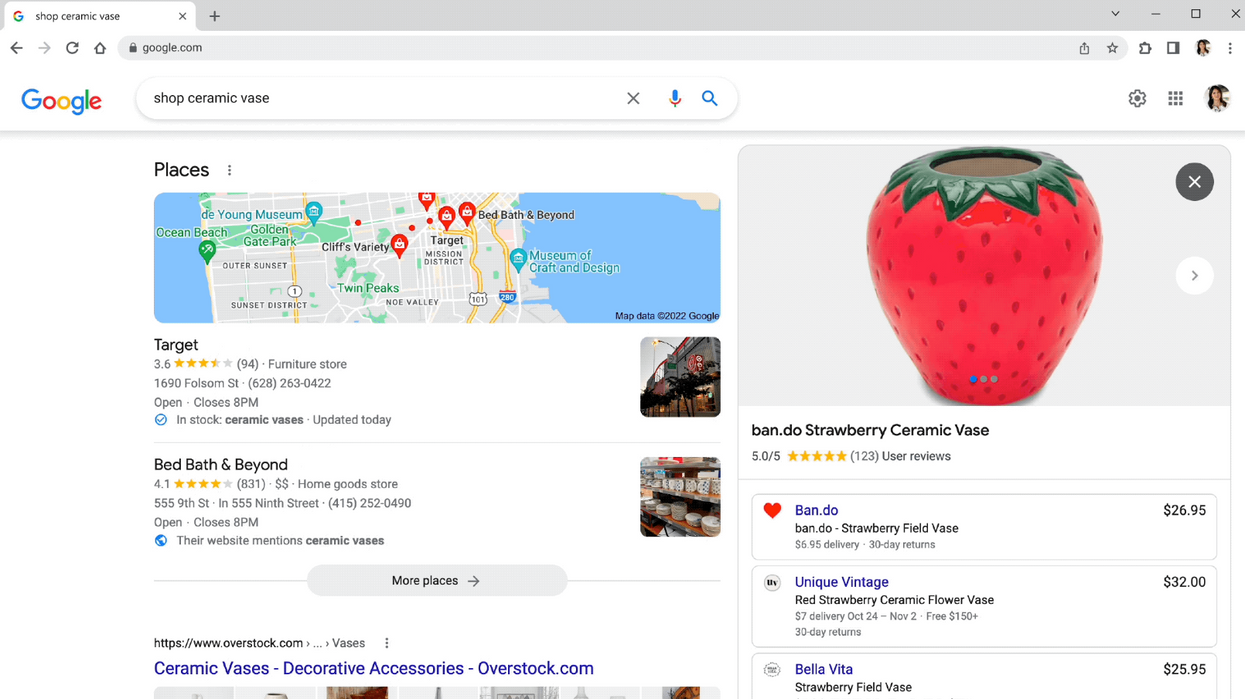Shopper Experience
20 October 2022
Google makes desktop shopping search results more visual
The pre-holiday shopping search updates from Google continue.

A second display shows product details in Google search. (Photo via Google)
The pre-holiday shopping search updates from Google continue.

A second display shows product details in Google search. (Photo via Google)
Following last month’s series of updates to shopping-oriented search functionalities, Google has one more release as it gets ready for the holiday season: Upgrades to visual shopping search experience for desktop.
Last month, Google introduced a new functionality that allows users to start a search for a product by typing “shop” before the item they are seeking. With the features launched this week, that search will now bring up what Google said is a more visual feed showing products, brands, articles and videos from around the web, according to a blog post.
Additionally, filters will allow users to hone in on specifics of a product like type, brand, a particular retailer, or whether it is at a store nearby or on sale.
Clicking on a product will also populate a second display, with details such as offers from different merchants and reviews. This appears without closing out of the initial search.
It’s the latest upgrade to arrive this year as Google seeks to boost shopping at a time when it is seeing more searches for products "in stock near me," and make product searches a feature of the primary search experience as opposed to the province of only the Shopping tab.
Along with the ability to start a search with “Shop,” other new features announced last month included the ability to shop a particular look, view trending products, curate a product buying guide and a feature that displays products in 3D. That was added to a list of tools that it surfaced to help brands get ready for the holidays, and a series of features for retailers and new ad formats announced throughout the year.
It comes as Amazon has become the place where Americans are most likely to start a shopping search, and executives have voiced revelations about TikTok becoming a favored place to search for information by Gen Z. Google remains a primary destination for brands and retailers to advertise products as they seek to reach customers.Labor disputes on the West Coast could cause further disruption heading into peak season.
When the first half of 2023 is complete, imports are expected to dip 22% below last year.
That’s according to new data from the Global Port Tracker, which is compiled monthly by the National Retail Federation and Hackett Associates.
The decline has been building over the entire year, as imports dipped in the winter. With the spring, volume started to rebound. In April, the major ports handled 1.78 million Twenty-Foot Equivalent Units. That was an increase of 9.6% from March. Still it was a decline of 21.3% year over year – reflecting the record cargo hauled in over the spike in consumer demand of 2021 and the inventory glut 2022.
In 2023, consumer spending is remaining resilient with in a strong job market, despite the collision of inflation and interest rates. The economy remains different from pre-pandemic days, but shipping volumes are beginning to once again resemble the time before COVID-19.
“Economists and shipping lines increasingly wonder why the decline in container import demand is so much at odds with continuous growth in consumer demand,” said Hackett Associates Founder Ben Hackett, in a statement. “Import container shipments have returned the pre-pandemic levels seen in 2019 and appear likely to stay there for a while.”
Retailers and logistics professionals alike are looking to the second half of the year for a potential upswing. Peak shipping season occurs in the summer, which is in preparation for peak shopping season over the holidays.
Yet disruption could occur on the West Coast if labor issues can’t be settled. This week, ports from Los Angeles to Seattle reported closures and slowdowns as ongoing union disputes boil over, CNBC reported. NRF called on the Biden administration to intervene.
“Cargo volume is lower than last year but retailers are entering the busiest shipping season of the year bringing in holiday merchandise. The last thing retailers and other shippers need is ongoing disruption at the ports,” aid NRF Vice President for Supply Chain and Customs Policy Jonathan Gold said. “If labor and management can’t reach agreement and operate smoothly and efficiently, retailers will have no choice but to continue to take their cargo to East Coast and Gulf Coast gateways. We continue to urge the administration to step in and help the parties reach an agreement and end the disruptions so operations can return to normal. We’ve had enough unavoidable supply chain issues the past two years. This is not the time for one that can be avoided.”